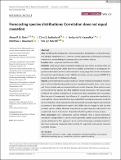Forecasting species distributions : correlation does not equal causation
Abstract
Aim Identifying the mechanisms influencing species' distributions is critical for accurate climate change forecasts. However, current approaches are limited by correlative models that cannot distinguish between direct and indirect effects. Location New Hampshire and Vermont, USA. Methods Using causal and correlational models and new theory on range limits, we compared current (2014?2019) and future (2080s) distributions of ecologically important mammalian carnivores and competitors along range limits in the northeastern US under two global climate models (GCMs) and a high-emission scenario (RCP8.5) of projected snow and forest biomass change. Results Our hypothesis that causal models of climate-mediated competition would result in different distribution predictions than correlational models, both in the current and future periods, was well-supported by our results; however, these patterns were prominent only for species pairs that exhibited strong interactions. The causal model predicted the current distribution of Canada lynx (Lynx canadensis) more accurately, likely because it incorporated the influence of competitive interactions mediated by snow with the closely related bobcat (Lynx rufus). Both modeling frameworks predicted an overall decline in lynx occurrence in the central high-elevation regions and increased occurrence in the northeastern region in the 2080s due to changes in land use that provided optimal habitat. However, these losses and gains were less substantial in the causal model due to the inclusion of an indirect buffering effect of snow on lynx. Main conclusions Our comparative analysis indicates that a causal framework, steeped in ecological theory, can be used to generate spatially explicit predictions of species distributions. This approach can be used to disentangle correlated predictors that have previously hampered understanding of range limits and species' response to climate change.
Citation
Sirén , A P K , Sutherland , C S , Karmalkar , A V , Duveneck , M J & Morelli , T L 2022 , ' Forecasting species distributions : correlation does not equal causation ' , Diversity and Distributions , vol. Early View . https://doi.org/10.1111/ddi.13480
Publication
Diversity and Distributions
Status
Peer reviewed
ISSN
1366-9516Type
Journal article
Description
This research was funded by the U.S. Department of the Interior Northeast Climate Adaptation Science Center, which is managed by the U.S. Geological Survey National Climate Adaptation Science Center. Additional funding was provided by T-2- 3R grants for Nongame Species Monitoring and Management through the New Hampshire Fish and Game Department and E-1- 25 grants for Investigations and Population Recovery through the Vermont Fish and Wildlife Department.Collections
Items in the St Andrews Research Repository are protected by copyright, with all rights reserved, unless otherwise indicated.

